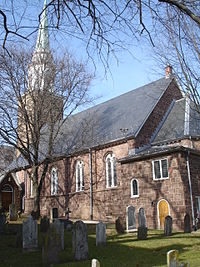Christ Church, New Brunswick, New Jersey
| Christ Church | |
|---|---|
| The Rector, Church Wardens, and Vestrymen of Christ Church in the City of New Brunswick | |
| Christ Episcopal Church | |
 |
|
| Location | New Brunswick, New Jersey |
| Country | United States |
| Denomination | Episcopal |
| Churchmanship | Anglican Communion |
| Weekly attendance | 145 (2014) |
| Website | Christ Church New Brunswick |
| History | |
| Founded | 1761 |
| Events | Third public reading of the Declaration of Independence (which occurred in New Brunswick, July 8, 1776 |
| Associated people | Brigadier General Anthony White, Patriot John Antill, 2nd Battalion of the New Jersey Volunteers (a Loyalist force) |
| Architecture | |
| Status | Church |
| Functional status | Active |
| Architect(s) | Philip French (1750 original) Henry Dudley & Frederick Wills (1852 rebuild) |
| Architectural type | Mission parish |
| Style |
|
| Years built | 1742–49 |
| Groundbreaking | 1742 |
| Completed | 1750 |
| Specifications | |
| Number of spires | 1 |
| Materials | Sandstone rubble while the stone tower is composed of irregularly sized shaley sandstone rubble with a copper roof |
| Administration | |
| Episcopal area | Episcopal Church in the United States of America |
| Diocese | Episcopal Diocese of New Jersey |
| Province | Province II |
| Clergy | |
| Bishop(s) | William H. Stokes |
| Rector | Reverend Joanna P. Hollis |
| Assistant | Reverend Joan Fleming |
| Deacon(s) | Venerable Pete S. Cornell(Archdeacon for Deacons) |
| Laity | |
| Organist(s) | John Sheridan, DMA |
| Churchwarden(s) | Paul Ambos |
| Business manager | Jonathan Gloster |
| Youth ministry coordinator | Andrew Murphy |
| Music group(s) | Andrea Cunnell |
| Parish administrator | Julia Utz, BM, MFA |
|
Christ Episcopal Church
|
|

Christ Church, from 1937 Buildings Survey
|
|
| Location | New Brunswick, New Jersey |
| Coordinates | 40°29′44.03″N 74°26′36.55″W / 40.4955639°N 74.4434861°WCoordinates: 40°29′44.03″N 74°26′36.55″W / 40.4955639°N 74.4434861°W |
| Area | 1.1 acres (0.45 ha) |
| Built | 1750 |
| NRHP Reference # | 89000994 |
| NJRHP # | 1857 |
| Significant dates | |
| Added to NRHP | July 28, 1989 |
| Designated NJRHP | June 20, 1989 |
| Details | |
|---|---|
| Established | 1754 |
| Location | New Brunswick, New Jersey |
| Country | United States |
| Type | Church |
| Owned by | Christ Church New Brunswick |
| No. of interments | 1,253 |
| Website | Christ Church New Brunswick Churchyard |
| Find a Grave | Christ Church Graveyard |
Christ Church or Christ Episcopal Church is a historic Episcopal church in New Brunswick, Middlesex County, New Jersey.
In 1701 English minister Thomas Bray formed the Society for the Propagation of the Gospel in Foreign Parts (SPG) to minister to the new English settlers. In 1711 a group of Anglicans were holding service in an old broken down townhouse in Piscataway that they shared with a group of Baptists. Under the influence of William Skinner, an SPG minister, in 1717 a timber frame church was built, which was completed in 1724, to replace the broken down townhouse. St. James Parish in Piscataway continued to grow, including members from higher up the Raritan River in New Brunswick. The demand was so great that a group gathered in 1742 to construct another church, to be called Christ Church, on the New Brunswick side of the River.
Although construction began in 1742, title to the land was not obtained until 1745. This was because one of the original church planners was Philip French, who was the largest land owner in New Brunswick. French did not believe in selling land, but for public buildings that would benefit the community he did provide land leases at nominal rates. For the land to build Christ Church, he charged a yearly rent of “one peppercorn a year, only if asked.” The lease for the land is still on display in the Rector’s office at Christ Church. Throughout the early years, Christ Church remained a mission parish. It would not receive a royal charter as an independent parish until 1761.
While it was believed that the parish was fully behind fight for independence, the reality is that during the Revolution the parish was quite conflicted. Figures such as Col. John Nielson, and Brigadier General Anthony White did, in fact, fight on behalf of the Patriots. But the church also contained its share of Loyalists, such as John Antill, who fought with the 2nd Battalion of the New Jersey Volunteers (a Loyalist force).
...
Wikipedia

